《基础医学各论II》课件:消化系统药理学
- 格式:pdf
- 大小:1.21 MB
- 文档页数:62

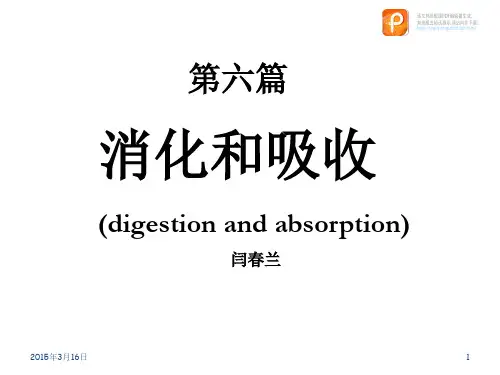

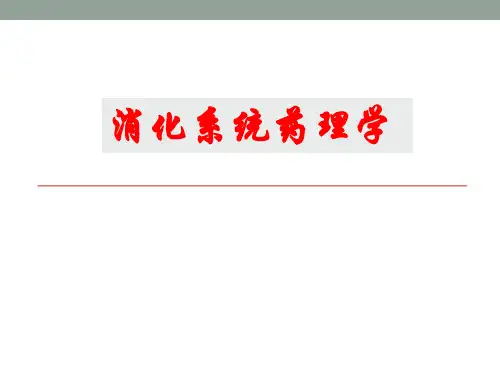

2023-10-29contents •消化系统概述•消化系统药物的作用机制•消化系统常见疾病的药物治疗•消化系统药物的不良反应及注意事项•消化系统药物的合理使用及管理目录01消化系统概述口腔、食道、胃、小肠、大肠等器官的组成及连接关系。
消化腺如唾液腺、胃酸、胆汁等分泌物的分泌及其作用。
消化系统的解剖结构消化系统的生理功能消化系统疾病的症状与诊断常见消化系统疾病的症状如腹痛、腹泻、恶心、呕吐等。
消化系统疾病的诊断方法如内窥镜、影像学检查、实验室检查等及其意义。
02消化系统药物的作用机制总结词详细描述抗酸药总结词详细描述胃肠动力药抗炎药总结词详细描述抗溃疡药是一类能够促进溃疡愈合、缓解疼痛的药物,主要用于治疗胃溃疡、十二指肠溃疡等消化系统疾病。
详细描述抗溃疡药主要通过抑制胃酸分泌,促进溃疡愈合,缓解胃溃疡、十二指肠溃疡等疾病的症状。
常见的抗溃疡药包括奥美拉唑、雷尼替丁等。
总结词抗溃疡药VS杀虫药总结词详细描述03消化系统常见疾病的药物治疗胃食管反流病的药物治疗030201炎症性肠病的药物治疗肝硬化并发症的药物治疗门静脉高压症治疗药物肝性脑病治疗药物腹水治疗药物胰腺炎的药物治疗抑制胰酶分泌药物如头孢菌素、喹诺酮类等,预防和治疗胰腺感染。
抗生素止痛药04消化系统药物的不良反应及注意事项药物过敏胃肠道反应药物相互作用长期使用副作用抗酸药的常见不良反应及注意事项胃肠动力药的常见不良反应及注意事项部分患者可能出现药物过敏反应,如皮疹、瘙痒等症状。
药物过敏心血管不良反应肝功能损害青光眼和尿潴留胃肠动力药可能会引起心律失常、心绞痛、高血压等心血管不良反应。
长期使用胃肠动力药可能会对肝脏造成损害,引起肝功能异常。
胃肠动力药可能会增加眼内压和尿潴留的风险,对有相关疾病的患者应慎用。
抗炎药的常见不良反应及注意事项胃肠道反应过敏反应肝肾损害心脑血管不良反应抗溃疡药的常见不良反应及注意事项药物过敏抗溃疡药可能会刺激胃肠道,引起恶心、呕吐、腹泻等症状。

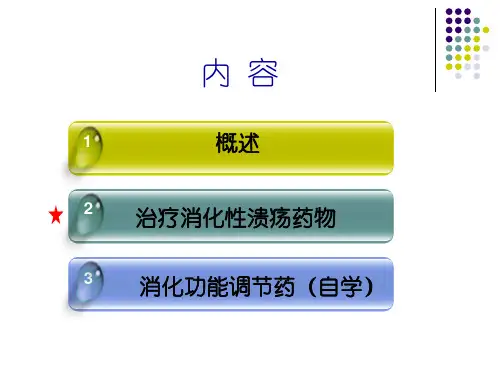
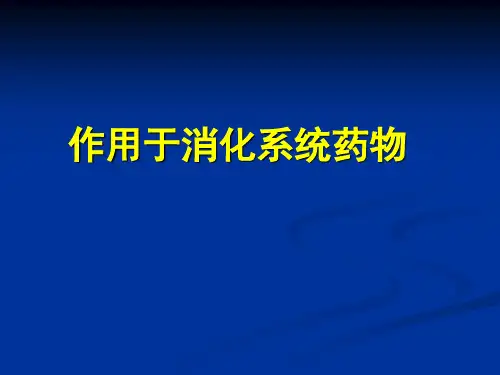
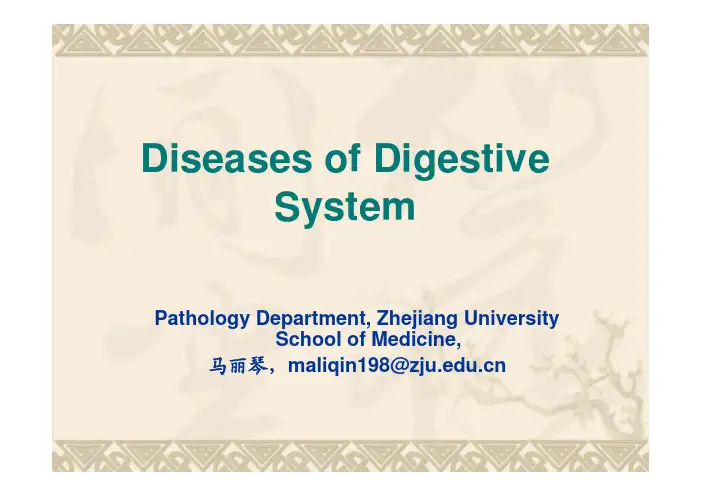
Diseases of DigestiveSystemPathology Department, Zhejiang UniversitySchool of Medicine,马丽琴,maliqin198@Oesophagusliver small intestine Stomach Pancreaslarge intestinesinus ventriculiStructure of Digestive tubemucous layer (粘膜层) submucosa (粘膜下层) muscular layer (肌层) serous membrane (浆膜层)Normal gastric mucosaNormal gastric mucosaNormal gastric mucosaDiseases of Digestive System Gastritis (acute, chronic )Peptic ulcerAppendicitisViral hepatitisCirrhosis of liverTumorAcute gastritisEarly changes :mucosal congestion and edema. Severe changes:mucosal erosions and hemorrhage. Inflammatory infiltrationClinical courseAsympatomaticEpigastric pain , nausea , vomiting , hematemesis and potentially fatal blood loss.Chronic gastritisChronic Superficial gastritis, CSG Chronic Atrophic gastritis, CAG Verrucosa gastritisHypertrophic gastritisChronic Superficial gastritis, CSGMucosal congestion and edema.Chronic inflammatory cell infiltration (mainly lymphocytes and plasmacytes) in superficial mucosa.Glands keep intactChronic superficial gastritisChronic Atrophic gastritis, CAG Glandular atrophy , decrease or loss of specialized secretory cell ( parietarl cells , chief cells )Chronic inflammatory cell infiltration and H.pylori-induced proliferation of lymphoid tissue within the gastric mucosa.Intestinal and pseudopyloric metaplasia.Chronic atrophic gastritisChronic atrophic gastritisIntestinal MetaplasiaRefers to the replacement of gastric epithelium with columnar and goblet cells of intestinal variety.Gastric intestinal type carcinomas appear to arise from dysplasia of this metaplastic epithelium.intestinal metaplasiaThe difference between Type A and Type BType A Type BLocation corpus antrumGastric secretion severe moderateParietal cell Antibody + -intrinsic antibody + -Serum gastrin higher lowerAssociated disease pernicious anemia iron deficiencyanemiaAutoimmune + -endocrine disorders frequent noneMalignant change none about 8%Gastritis verrucosaHypertrophic gastritisEtiology and PathogenesisAutoimmune damage:Autoimmune damage appears to be a major causal factor in type A gastritis.A variety of mucosal irritantstobacco, alcohol, salicylates(水杨酸盐), and reflux of biliary secretions. It may be closely correlated with type B gastritis.Helicobacter pyloriHelicobacter pyloriHP(结晶紫染色法)Clinicopathological CorrelationAsymptomaticLower gastric acid secretion and decreased secretion of pepsin.Epigastric discomfort, nausea and vomiting and, in more severe forms, occult bleeding(隐性出血) or even massive hemorrhage.Pernicious anemia(恶性贫血)Relation to gastric-peptic ulcer and gastric cancer.Peptic UlcerPeptic ulcer is a chronic , most often solitary, lesions that occurin any portion of gastrointestinal tract exposed to the aggressive action of acid-peptic juices.MorphologyGross appearance:1. Shape round, sharply, punched-out holes in the mucosa.2. Size usually less then 2cm in diameter.3. Base remarkably clean and flat.4. Locationin order of frequency, the anterior wall of the first portion of the duodenum, the posterior wall of the duodenum, and the lesser curvature of the stomach.5. The mucosal margin not elevated.6. The mucosal folds radiating from the crater.Chronic gastric ulcerGastric wall Chronic duodenal ulcerMicroscopic appearance1. Four histological zones of the ulcer floor: (1) Fibrinous exudate mixed with neutrophilsand tissue debris(Zone of inflammatory exudate)(2) Necrotic tissue(Zone of necrotic materials)(3) Granulation tissue(Zone of granulation tissue).(4) Fibrous collagenous scar(Zone of collagenous scar )Zone of inflammatory exudate Zone of necrotic materialsZone of granulation tissueMicroscopic appearance2. Thickened and occasionallythrombosed vessel wall orobliterative endoarteriolitis in scar tissue.3. The margins showing chronicgastritis.Clinicopathological CorrelationEpigastric pain .Nausea, vomiting, sour regurgitation, belching, anorexia(食欲减退).Occult bleeding(隐性出血) or massive hemorrhage.Complications1、Healing2、Hemorrhage1/33、Perforation5%4、Pyloric stenosis 2%—3%5、Malignant transformation 1%Etiology and PathogenesisThe exact cause of peptic ulcer is still unknown.1. Imbalance between acid-pepsin and mucosal resistance:Increased acid-pepsin secretion , decreased mucosal resistence, or the two actions together are ulcerogenic.(1) Duodenal ulcers from hyperacidity, increasednumber of parietal cells(2) Gastric ulcers are associated with normal oreven low gastric acid levels and possiblyresult from lowered mucosal resistence, bile reflux gastric, mucosal ischemia.2.Disturbance of neuro-endocrine system:Emotional factors --- vagal stimulationincreased3. H.pyloriAll patients with duodenal ulcers and about 70% of those with gastric ulcers.Antibiotic treatment of HP--tends to recurrenceAppendicitisEtiology and PathogenesisBacterial invasionLuminal obstructionClassification and MorphologyAcute appendicitis1. Acute simple appendicitis2. Acute suppurative appendicitis3. Acute gangrenous appendicitiscomplication: abscess around appendix acute diffuse peritonitisChronic appendicitisAcute suppurative appendicitisAcute phlegmonous appendicitisAcute phlegmonous appendicitis。
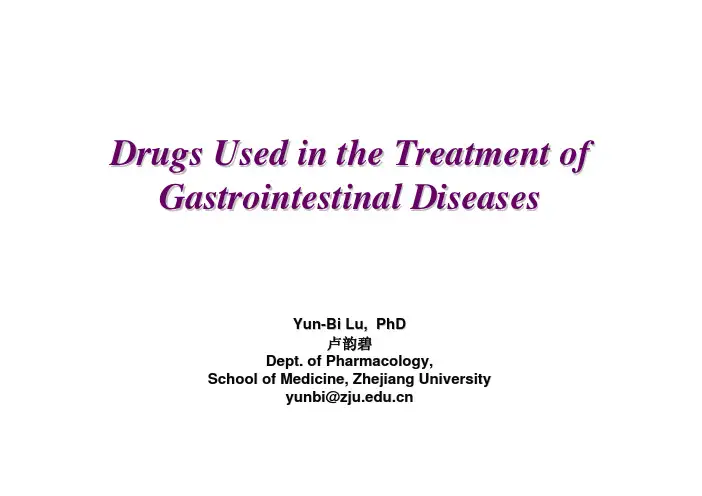
Drugs Used in the Treatment of Gastrointestinal DiseasesYun-Bi Lu, PhD卢韵碧Dept. of Pharmacology,School of Medicine, Zhejiang Universityyunbi@1. Hepatic, pancreaticand biliary disorders2. Acid-peptic disorders3.Gastrointesinal motility Disorders4. Inflammatorybowel diseasesGastrointestinal drugs A. Drugs used for acid-peptic A. Drugs used fordisorders(抗消化性溃疡药) B. Modulators of gastrointestinal functions (消化功能调节药)Symptoms:Upper abdominal burning or hunger painEmesia(呕吐), belching (嗳气)The feature of peptic ulcer disease:High incidence, frequent Recurrence, Drugtherapeutics is the main way for treatment. Ulcer complicationUlcer bleeding (出血)Ulcer perforation (穿孔)Pyloristenosis(幽门狭窄)Canceration(癌变)Acid-peptic disorders1)Peptic ulcer disease (PUD)chronic inflammation due to Helicobacter pylori2) Drug-induced mucosal injury, especially bynon-steroidal anti-inflammatory drugs (NSAIDs)3) Acute stress ulcers (应激)4) Gastroesophageal reflux disease (GERD)5) Pathologic acid-hyper-secretory conditions (e.g.Zollinger-Ellison syndrome)Helicobacter pylori infectionGastroesophageal reflux disease (GERD)Abnormal reflux in the esophagusPeptic ulcerA.Drugs used for peptic ulcers ▪Antacids 抗酸药▪Drugs affecting gastric acid secretion抑制胃酸分泌药Muscarinic receptor antagonistsH2receptor antagonistsH+-K+ ·ATPase inhibitors (proton pump inhibitors) Gastrin receptor antagonists▪Antimicrobial drugs (Helicobacter pylori)抗菌药▪Mucosal protective drugs 黏膜保护药(Proton pump)Pharmacological effect×AntacidsNaHCO 3Mg(OH)2Mg 2S 3O 8Al(OH)3CaCO 3Sodium (bicarbonate )Salts of magnesium (carbonate, hydroxide,trisilicate )Salts of aluminum (aluminum hydroxide)Calcium (carbonate )2. Clinical usesnonprescription remedies for the treatment of dyspepsia(消化不良) symptom and minor episodes of heartburn.AntacidsAntacids3. Adverse effects•Constipation (salt of aluminum) 便秘•Diarrhea(salt of magnesium ) 腹泻Combination products such as maalox(氢氧化铝)•Hypercalcium which can cause renal failure(Calcium)•Hypernatremia(sodium-containing antacids)All antacids are generally regarded as safe in pregnancy.4.Drug interactions, Administration and dosage •To avoid or reduce drug interaction, other medication should NOT be taken within 1-2 hours of taking anantacids; (for example, tetracycline四环素),•Should not be taken continuously for more than 2weeks.铝碳酸镁片(达喜)[药品名称]通用名称:铝碳酸镁片[成份]本品每片含0.5克铝碳酸镁。
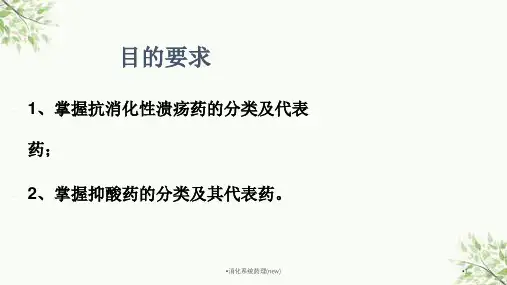
Drugs Used in the Treatment of Gastrointestinal DiseasesYun-Bi Lu, PhD卢韵碧Dept. of Pharmacology,School of Medicine, Zhejiang Universityyunbi@1. Hepatic, pancreaticand biliary disorders2. Acid-peptic disorders3.Gastrointesinal motility Disorders4. Inflammatorybowel diseasesGastrointestinal drugs A. Drugs used for acid-peptic A. Drugs used fordisorders(抗消化性溃疡药) B. Modulators of gastrointestinal functions (消化功能调节药)Symptoms:Upper abdominal burning or hunger painEmesia(呕吐), belching (嗳气)The feature of peptic ulcer disease:High incidence, frequent Recurrence, Drugtherapeutics is the main way for treatment. Ulcer complicationUlcer bleeding (出血)Ulcer perforation (穿孔)Pyloristenosis(幽门狭窄)Canceration(癌变)Acid-peptic disorders1)Peptic ulcer disease (PUD)chronic inflammation due to Helicobacter pylori2) Drug-induced mucosal injury, especially bynon-steroidal anti-inflammatory drugs (NSAIDs)3) Acute stress ulcers (应激)4) Gastroesophageal reflux disease (GERD)5) Pathologic acid-hyper-secretory conditions (e.g.Zollinger-Ellison syndrome)Helicobacter pylori infectionGastroesophageal reflux disease (GERD)Abnormal reflux in the esophagusPeptic ulcerA.Drugs used for peptic ulcers ▪Antacids 抗酸药▪Drugs affecting gastric acid secretion抑制胃酸分泌药Muscarinic receptor antagonistsH2receptor antagonistsH+-K+ ·ATPase inhibitors (proton pump inhibitors) Gastrin receptor antagonists▪Antimicrobial drugs (Helicobacter pylori)抗菌药▪Mucosal protective drugs 黏膜保护药(Proton pump)Pharmacological effect×AntacidsNaHCO 3Mg(OH)2Mg 2S 3O 8Al(OH)3CaCO 3Sodium (bicarbonate )Salts of magnesium (carbonate, hydroxide,trisilicate )Salts of aluminum (aluminum hydroxide)Calcium (carbonate )2. Clinical usesnonprescription remedies for the treatment of dyspepsia(消化不良) symptom and minor episodes of heartburn.AntacidsAntacids3. Adverse effects•Constipation (salt of aluminum) 便秘•Diarrhea(salt of magnesium ) 腹泻Combination products such as maalox(氢氧化铝)•Hypercalcium which can cause renal failure(Calcium)•Hypernatremia(sodium-containing antacids)All antacids are generally regarded as safe in pregnancy.4.Drug interactions, Administration and dosage •To avoid or reduce drug interaction, other medication should NOT be taken within 1-2 hours of taking anantacids; (for example, tetracycline四环素),•Should not be taken continuously for more than 2weeks.铝碳酸镁片(达喜)[药品名称]通用名称:铝碳酸镁片[成份]本品每片含0.5克铝碳酸镁。
辅料为:玉米淀粉、甘草醇、糖精钠、硬脂酸镁、薄荷香精、香蕉香精。
[性状]本品为白色片。
[作用类别] 本品为抗酸与胃黏膜保护类非处方药药品。
[适应症]1.慢性胃炎。
2.与胃酸有关的胃部不适症状,如胃痛、胃灼热感(烧心)、酸性嗳气、饱胀等。
[规格] 0.5克[用法用量] 口服。
一次1-2片,一日3次。
餐后1-2小时、睡前或胃部不适时服用。
[不良反应] 偶见便秘、稀便、口干和食欲缺乏。
[禁忌]详情见说明书[注意事项]………..A.Drugs used for peptic ulcers ▪Antacids抗酸药▪Drugs affecting gastric acid secretion抑制胃酸分泌药Muscarinic receptor antagonistsH2receptor antagonistsH+-K+ ·ATPase inhibitors (proton pump inhibitors) Gastrin receptor antagonists▪Antimicrobial drugs (Helicobacter pylori)抗菌药▪Mucosal protective drugs 黏膜保护药cimetidine×(Proton pump)Cimetidine(西咪替丁)1. Pharmacological effects•Blocking H2 receptors, decreasing H+secretion; decreaseprotease secretion.•immunology modification(activate)Histamine →T cell H2receptor →histamine induced suppresser factor (HSF) →inhibit immuno logical function •Cardiac vascular function, depress HR and cardiac contractility in vitro (need relative high dose)A.Drugs used for peptic ulcersCimetidine(西咪替丁)2. Clinical uses▪Duodenal and gastric ulcer: relieving symptoms,promoting healing of ulcers, and preventing ulcers▪Acute stress ulcers (bleeding)▪Zollinger-Ellison syndrome, gastroesophageal reflux disease (heartburn)▪Immunology depression and tumor (assistant)Cimetidine(西咪替丁)3. Adverse effects▪Side effects: constipation, diarrhea, tiredness, muscular pain, etc.▪CNS effects: headache, dizziness, confusion,hallucination, etc.(elderly, long-term uses)▪Endocretion effects: antiandrogen, gynecomastia(男性乳房发育), galactorrhea(溢乳),reduced sperm count, and male sexual dysfunction▪Blood dyscrasias: rarely4.EliminationUrinary excretion, the dose should be modified in patients with renal impairment5. Drug interactionsOther H2receptor antagonists Ranitidine 雷尼替丁4~10 times more potent; Duration of action is comparable.Minimal side effects, weakly inhibiting CYP Famotidine法莫替丁Similar to ranitidine, but no inhibiting CYP Nizatidine尼扎替丁Bioavailability is near 100%, principally eliminated by kidneyOmepranzole×(the proton pump)Omeprazole(奥美拉唑)1. Pharmacological effects▪Inhibiting gastric acid secretion by various stimuli (histamine, gastrin, aspirin, ethanol, stress)▪Inhibiting H. pylori2. Clinical uses▪Duodenal and gastric ulcer:relieving symptoms, promoting healing of ulcers, used with antimicrobial regimens to eradicate H. pylori▪Reflux esophagitis▪Zollinger-ellison syndromeOmeprazole(奥美拉唑)3. Adverse effects▪Side effects: nausea, headache, diarrhea, constipation and rash occur but are uncommon▪Increase of gastric carcinoid tumor(肿瘤样增生): prolongated hypochlorhydria and secondaryhypergastrinemia(only found by animal experiments)▪Others: gynecomastia(男性乳房发育),hypersensitivity 4.Drug interactions▪It is metabolized by hepatic P450 (CYP2C19);▪Inhibiting hepatic P450, raising plasma concentrations of warfarin, phenytoin, diazepam, etc.M receptorantagonists×(the proton pump)×Proglumide丙谷胺▪Drugs affecting gastric acid secretion ▪Muscarinic receptor antagonistsAtropine 阿托品•Decrease gastric acid secretion by blockingM3receptor on parietal cell;•Decrease histamine release by blockingM1receptor on parasympathetic neuronal ganglion;M receptor on enterochromaffin-like cell (ECL cell);•Decrease gastrin release by blockingM receptor on G cell▪Pirenzepine(哌仑西平)1. Pharmacological effects and clinical uses▪High affinity for M1-and low affinity for M2-receptors of thesmooth muscle of the ileum and urinary bladder.▪Blocking of M1-muscarinic receptors in autonomic ganglia, inhibiting HCl secretion2. Adverse effects▪Atropine-like effects, especially at larger dosesOther drugs▪Telenzepine(替仑西平)▪Propantheline bromide (溴丙胺太林)A.Drugs used for peptic ulcers Mucosal protective drugsEffects:Protecting the gastric and duodenal mucosa from damage induced by acid and pepsin Misoprostol米索前列醇Sucralfate硫糖铝Colloidal bismuth subcitrate胶体次枸橼酸铋Misoprostol米索前列醇1. Pharmacological effects▪Inhibiting gastric acid secretion▪Promoting mucus and HCO-secretion, and mucosal repair32. Clinical usesOnly approved for the prevention of NSAIDs-induced gastric Ulcer.3. Adverse effectsSide effects (13%):, abdominal pain, diarrhea, headache, nausea etc.Contraindicated in pregnancy women(Abortifacient property)Sucralfate硫糖铝A sulfated disaccharide(二糖)complex of aluminum hydroxideSucralfate硫糖铝1. Pharmacological effects▪Binding to tissue proteins and forms a protective barrier ▪Enhancing cell restitution and re-epithelization.▪Weakly inhibiting H.Pylori growth.2. Clinical uses and Administration▪Duodenal ulcers (with proton pump inhibitors), seldom used.▪Take sucralfate1 hour before meals▪Four times a day before meals and at bedtime3. Adverse effects▪Constipation occurs in 2% due to the aluminum saltBismuth Compounds(铋剂) Colloidal bismuth subcitrate(CBS) 胶体次枸橼酸铋1. Pharmacological effects▪Probably coats ulcers and erosions, creating a protective layer against acid and pepsin▪Stimulate prostaglandin, mucus, and bicarbonate secretion▪Antimicrobial activity against H pylori2. Clinical uses▪Dyspepsia and acute diarrhea, ulcer.3.Adverse effects▪Blackening of the stool▪Bismuth toxicity: encephalopathy(铋剂神经毒性-急性可逆性脑病)A.Drugs used for peptic ulcers▪Mucosal protective drugs▪Misoprostol米索前列醇▪Enprostil恩前列素▪Sucralfate硫糖铝▪Colloidal bismuth subcitrate胶体次枸橼酸铋▪Teprenone替普瑞酮▪Marzulene麦滋林▪Smectite思密达A.Drugs used for peptic ulcers▪Antimicrobial drugs(for Helicobacter pylori)1. Anti-ulcer drug regimen▪H+-K+·ATPase inhibitors; bismuch; sulralfate(硫糖铝)▪Antimicrobial drugs2. Antimicrobial drugs▪metronidazole(甲硝唑); amoxicillin (阿莫西林);▪tetracycline (四环素); gentamicin(庆大霉素);▪clarithromycin(克拉霉素)Gastrointestinal drugs A. Drugs used for acid-peptic A. Drugs used fordisordersB. Modulators of gastrointestinalfunctions。